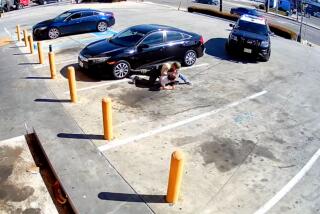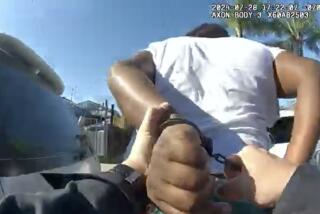Riverside Sheriff Blasts Beating by 2 Deputies
- Share via
Reeling from an international uproar over a televised beating by two of his deputies, Riverside County Sheriff Larry Smith bitterly denounced their actions Wednesday and announced that the one suspect taken into custody had been released after officials concluded that he was not the driver of a pickup truck loaded with suspected illegal immigrants.
By Wednesday evening, all the other people detained for entering the country illegally were released, and officials acknowledged that the driver of the truck appears to have eluded authorities. Although they allegedly entered the country illegally, the passengers from the vehicle will be allowed to remain in the United States for six months so they can assist authorities investigating the incident.
In Riverside, the swirl of the day’s events was capped by Smith’s stern press conference, which scores of reporters attended and which took place inside the besieged sheriff’s headquarters. Roads in the area were blocked off for crowd control, and sheriff’s officials said they had been deluged with calls from around the world.
Outside, demonstrators chanted in protest, and civil rights lawyers representing the two people struck by Deputies Kurt Franklin and Tracy Watson said they were preparing to file a lawsuit today against the department.
The lawsuit, they said, will be filed on behalf of the two victims of the beating, Enrique Funes Flores--also known as Adrian Flores Martinez--and his companion, Alicia Sotero Vasquez. Sotero said Wednesday that she had given a false name--Leticia Gonzalez Gonzalez--in fear when authorities interviewed her after the beating.
In an interview Wednesday with The Times, Sotero said she still was in pain from the blows inflicted on her and mystified by the ferocity of the deputies who delivered them. “I don’t know why they did what they did,” she said.
The deputies were suspended with pay the day of the beating. Both have hired attorneys and have stayed out of public view.
At his press conference, Smith did not comment about the prospect of lawsuits, but he joined those expressing dismay about the incident, which unfolded at the end of a wild, 80-mile, high-speed chase.
“I’m deeply concerned about the actions captured on the videotape,” said Smith, who spent the day meeting with federal and local officials--including a personal session with Los Angeles County Sheriff Sherman Block--as well as representatives of the Latino community and the Mexican Consulate, all in an effort to quell the furor over Monday’s incident. “From what is in the video, it appears to be a clear case of excessive use of force.”
In addition to vocal protests in Riverside and Los Angeles, police use-of-force experts at other departments expressed dismay at the deputies’ handling of the incident. In some ways, they said, Monday’s beating was an even worse exercise of police judgment than the 1991 beating of Rodney G. King. In that incident, King charged at the officers and resisted arrest after leading them on a chase.
But the videotape of Monday’s confrontation shows no such conduct on the part of the two people struck with the deputies’ batons. Although the beating was not as prolonged and fierce as the one inflicted on King, the apparent lack of provocation for the blows astounded some police officers at the LAPD and other departments.
Smith acknowledged that the glare of publicity was uncomfortable for his department. He complained that the coverage had distorted the overall image of his force, which he described as well-trained and disciplined, citing statistics showing that his 1,200 sworn personnel last year generated just 31 excessive force complaints, only two of which were sustained. The sheriff pledged a full internal investigation into Monday’s incident. In one particularly pointed moment, he also promised that his department will not shirk its responsibility to investigate itself.
“There will be,” he insisted, “no cover-up.”
Passengers Freed
But even as Smith tried to separate his agency from the work of two of its deputies, the day’s developments brought another embarrassing revelation for the organization.
The one person that the Sheriff’s Department had arrested in connection with the incident, Smith said Wednesday, was let go after investigators determined that he was not the driver of the pickup.
“The person, Mr. Flores Martinez, who we had originally charged and had suspected to be the driver, has been cleared,” Smith said. “He is not the driver. He met with members of the Mexican consul, and has been released to the INS. At this point, we do not know who the driver was.”
Police officers and sheriff’s deputies are trained to concentrate on arresting the driver at the end of a pursuit because that is the only person in a vehicle guilty of the crime of evasion.
Nineteen people were taken into custody after the chase. One was released Tuesday, and the 18 others were freed Wednesday. According to Rosemary Melville, deputy director of the Immigration and Naturalization Service’s Los Angeles district, they will be allowed to remain in the United States at least six months.
“We want them to be present and available and cooperative during this period of investigation,” Melville said. “We prefer that they not return to Mexico” during the inquiry.
Any who choose to go back to Mexico will be allowed to leave, she added, but the consulate has agreed to provide authorities here with addresses so they can be contacted as possible witnesses.
Shortly before 4 p.m. Wednesday, 18 of the detainees were brought to a dimly lighted processing area in the basement of the INS center in downtown Los Angeles. Looking freshly showered but scared and bewildered, their clothes dirty and their shoelaces removed, the detainees were processed out three at a time.
One voiced the concern that many seemed to share. “Will I be able to get permission to stay here?” that man asked.
By 5 p.m., he and the others were free.
As they left the INS building, a crowd outside whistled and cheered its support.
Not everyone backed the detainees, however. One woman carried a sign saying, “Go Home!” And another person shouted: “They deserved it!”
Joint Investigation
As authorities began the task of scrutinizing Monday’s incident, a rare joint team of FBI agents and Los Angeles County sheriff’s deputies was assigned to handle the investigation. The FBI has jurisdiction to investigate possible federal civil rights violations, and the incident occurred in Los Angeles County, giving the Sheriff’s Department jurisdiction as well.
Usually, federal authorities defer to locals in such investigations, only entering in earnest once local officials have decided not to prosecute a case or have unsuccessfully attempted to win convictions.
This time, however, the FBI and Los Angeles County Sheriff’s Department are cooperating from the outset, teaming up agents and deputies and intending to interview witnesses jointly. That approach could speed up the investigation, officials said.
A Riverside sheriff’s official said that both law enforcement agencies had inquired about interviewing Franklin and Watson, but that neither had been questioned yet. Sheriff Smith said Internal Affairs officials from his department also intend to question them, but are interviewing witnesses first.
Once the FBI and Los Angeles County Sheriff’s Department conclude their work, U.S. Atty. Nora Manella said, she and her staff will consult with Dist. Atty. Gil Garcetti to determine which office is better suited to prosecute any case that might be brought.
In general, federal authorities defer to state officials, in part because the federal government can later prosecute suspects if the state fails to get a conviction. The reverse is not true, however, because California’s double-jeopardy prohibition prevents it.
There could be advantages to pursuing the case federally, however. Federal sentencing laws provide for more serious punishment, up to 10 years in prison for civil rights violations.
And as officials weigh how to handle the case, political considerations loom for Garcetti, who is seeking reelection in November.
If a case is brought in state court, the publicity that usually accompanies the filing of charges is almost always favorable for prosecutors, experts noted. In the short term, they said, that could benefit Garcetti.
But memories remain vivid of the district attorney’s 1992 failure to secure convictions in the state court trial of the four LAPD officers charged with beating King. That case was brought by Garcetti’s predecessor, but the recent loss in the O.J. Simpson murder trial has reignited criticism of the district attorney’s office.
Garcetti declined to comment on the political implications of the new beating case, but predicted that it would move ahead quickly.
“Since we have all the witnesses in custody or we know where they are, we should be able, I think, to wrap up the investigation reasonably quickly,” Garcetti said. “I would hope within a matter of weeks as opposed to months they [sheriff’s officials and FBI agents] will submit their investigation to the U.S. attorney’s office and to this office.”
Possible Problem
Although their work is barely two days old, investigators also are grappling with what could prove to be a difficult aspect of the case. According to sources, Franklin and Watson both wrote incident reports about Monday’s pursuit, but the deputies appear to have prepared those reports after learning that their actions had been taped.
Unless Franklin and Watson prepared some written record that conflicts with the videotape, authorities would be handicapped should they choose to prosecute.
In the King case, Officer Laurence M. Powell completed an arrest report and Sgt. Stacey C. Koon filled out a sergeant’s log immediately after the confrontation with King and before learning that their actions had been captured on videotape. Neither of those documents noted that the vast majority of the blows to King were delivered after he was knocked from his feet and was writhing on the pavement, an omission that prosecutors powerfully exploited in the federal trial of the officers.
Confronted with the videotaped evidence, the officers’ lawyers attributed such lapses to the difficulty of remembering precise details from such a violent encounter, but prosecutors maintained that they had demonstrated that the officers knew their actions were improper when they committed them.
“I would say that the reports were extremely important evidence of intent,” said former Assistant U.S. Atty. Steven D. Clymer, one of the lead prosecutors in the King case and now a professor at Cornell Law School.
Although other evidence of the officers’ intent also was introduced, the inconsistencies between the tape and the reports were the most powerful tool for establishing that the police knew the beating was improper, Clymer said.
To find a police officer guilty of a civil rights violation, prosecutors need to show that the officer not only used excessive force but did so intentionally. Although the question of intent is less explicit in a state assault or excessive force case, prosecutors still need to show that the accused officer willfully used more force than was necessary to arrest a suspect.
Without evidence to demonstrate the intent of Deputies Watson and Franklin, prosecutions of the two men could be more problematic, Clymer and other analysts said.
Meyer reported from Riverside and Newton from Los Angeles. Staff writers Alan Abrahamson, Bettina Boxall, Edward J. Boyer, Tony Perry, Amy Pyle, Henry Weinstein and correspondent John Cox also reported from Los Angeles.
More to Read
Sign up for Essential California
The most important California stories and recommendations in your inbox every morning.
You may occasionally receive promotional content from the Los Angeles Times.











